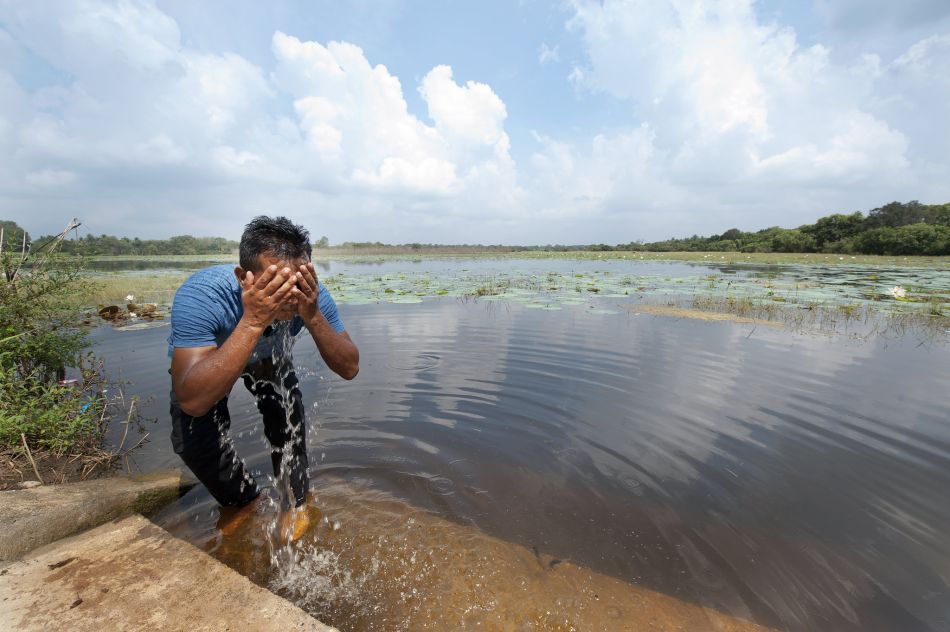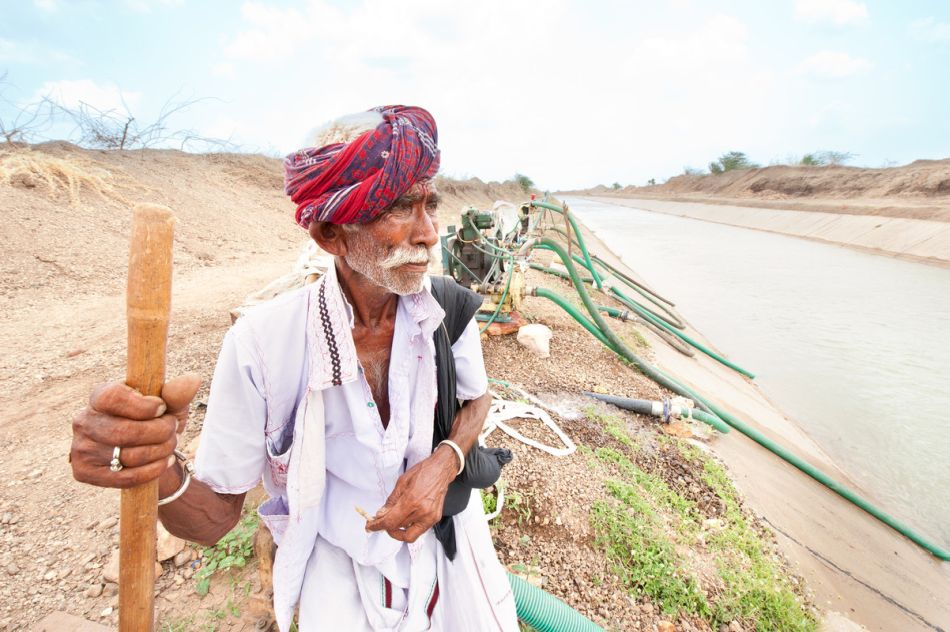Water is at the core of our planet’s biodiversity and helps to create a sustainable future
Nature provides “green infrastructure” that complements the dams, levees, and canals that humans construct. Aquifers store freshwater that can help us more effectively navigate droughts, mangroves can protect coastlines from destructive storms, and wetlands in some circumstances can help reduce the impact of flooding in downstream communities, for example. IWMI’s projects not only help enhance such green infrastructure (also known as “natural infrastructure”), but also support biodiversity and water systems that sustain lives and livelihoods around the world.

Measuring and monitoring rivers’ environmental flows
One of the ways IWMI has contributed to strengthening green infrastructure has been through the development of an environmental flow (e-flow) calculator. This tool quantifies the amount and quality of water that needs to be maintained within a river as e-flow so as to keep that river healthy, protect biodiversity, and ensure ecosystem services are sustainable. Today, IWMI continues to pioneer new approaches for the determination of e-flows.
Back in 2017, the IWMI e-flow model was adopted as the official global tool for countries to report on their water stress levels within the framework of the Sustainable Development Goals. IWMI’s online e-flow calculator has helped enable flow estimations for rivers around the world, and has been further developed and extended to include more detailed assessments in Nepal and within the vast Ganges river basin.
E-flows also can be used directly to protect ecosystems and help secure the livelihoods of vulnerable people who live in close contact with those ecosystems. One example where this type of sophisticated e-flow approach has been applied has been West Africa’s Upper Niger River and the Inner Niger Delta. Here, people living on the floodplain rely heavily on the river’s natural resources for their livelihoods and wellbeing, given the high density of fish which provide sustenance and food to locals, and the floodwaters which enable agricultural production and provide water to sustain livestock grazing. However, dam development and water diversions upstream of the Delta have disrupted e-flow considerably, and are impacting the area’s rich ecosystem services, threatening the environmental sustainability of the Upper Niger basin, and degrading soil fertility.
Going with the e-flow to protect biodiversity, ecosystems, and water quality
IWMI has also enjoyed significant success in implementing e-flow assessments in South Asia. In India, IWMI helped develop and implement the first-ever holistic e-flows assessment, for example, and conducted various related capacity building and training programs. As a direct result of these efforts, e-flows are now integrated into the Government of India’s National Mission for Clean Ganga (also known as the Namani Ganga Program). Meanwhile, across the border in Nepal, e-flow calculators have been included in the country’s National Irrigation Master Plan, after a series of IWMI-convened workshops showed government officials, private sector representatives, and citizen groups how healthy rivers can help serve multiple interests. With the support of Wetlands International, IWMI researchers subsequently carried out a holistic regional scale e-flow assessment using PROBFLO, an e-flow assessment tool. The study was carried out in two phases, including a PROBFLO risk model development and calibration phase (Phase I) which involved an evaluation of the socio-ecological consequences of current water resource developments. Phase ll involved the determination of e-flow requirements for the water resources of the aforementioned Upper Niger Basin.
While e-flow agreements take work, they play a key role in ensuring that vital natural infrastructure, such as wetlands, continue to operate well. Indeed, the rich biodiversity that wetlands often support provides services essential to human survival. Estimates put the global value of these ecosystem services—which include water purification and waste treatment, flood control, storm protection, fisheries, and carbon storage, among others—at $47 trillion a year (USD).
How can we manage groundwater resources more effectively?
E-flow data has the potential guide better management decisions for not only surface water resources, but also for aquifers. For instance, IWMI’s groundwater-based natural infrastructure tool—created under the Groundwater Solutions Initiative for Policy and Practice (GRIPP)—is designed to help countries and communities make better use of the subsurface to store, cleanse, attenuate, and provide environmental water flows.
In more arid regions of the world, many people often associate groundwater with overexploitation, depletion, and degradation. But if properly managed, groundwater can serve as a potent driver of resilience. So how does this look in practice?
Consider the example of farmers in flood-prone Gujarat state in western India. Like other farmers around the world, they sometimes find that too much water at the surface level can prove as problematic as too little. Indeed, farmers can find it impossible to grow anything in the wet season because their fields are covered with water. But in the dry season when they need water, there is very little in the ground.
To address this issue in Gujarat, a technique of managed aquifer recharge—known by its Gujarati name of Bhungroo (which means “drinking straw,” or “pipe”)—has subsequently helped farmers to time-shift water from the wet season to the dry. On the heels of that success, other parts of the world began taking note, with lessons learned from India’s utilization of managed aquifer recharge applied to West Africa in 2017. There, IWMI trialed the Bhungroo Irrigation Technology (BIT) with villages in northern Ghana, who must contend with chronic flooding and drought challenges. But could an aquifer recharge strategy that enjoyed success a continent away make a similar impact here?

From India to Ghana, tapping groundwater’s potential as a water storage solution
In northern Ghana, less than 20% of rainfall eventually seeps into the ground, even during floods. Most rainwater just runs off. Bhungroo Irrigation Technology seeks to capture and retain some of this rainfall with a borehole in the ground, which is surrounded by a deep pit designed to help flood waters soak into the surrounding earth. During the growing season, water is pumped out of the borehole to irrigate the crops. Later, when it rains, the pit replenishes the groundwater.
Managed aquifer recharge isn’t suitable for all locations, but where it does work, farmers have tripled their incomes. As in India, farmers in Ghana have been able to expand irrigated areas and grow more food. Although the technology remains expensive and requires investment from government or NGOs, local people have been trained to manage and maintain the Bhungroo system.
Bhungroo is just one of the ways that IWMI is working to put more water into the ground and help make this precious resource available all year round. After all, as heatwaves grow more extreme, one of the best places to store water is underground where it cannot evaporate. Another benefit of managed aquifer recharge is that underground water supplies are accessible and available to large numbers of smallholder farmers, who can extract what they need when they need it with solar-powered pumps.
As a result of IWMI’s work in the realms of e-flow monitoring and aquifer recharge, water management for rivers and aquifers has been strengthened. Still, there remains considerable room for improvement. Although IWMI has made progress with training and e-flow calculators, a persistent issue is that various government departments tasked with different aspects of water management don’t yet see the need to cooperate more closely. However, with time it is hoped that water managers at all levels will recognize that built water storage and natural water storage, utilized in tandem with one another, have the potential to help realize a more sustainable and water-secure future for all.
It’s about more than just water.

